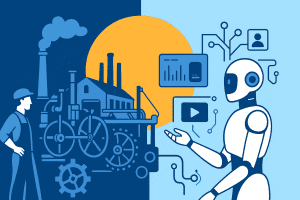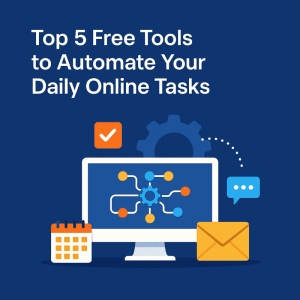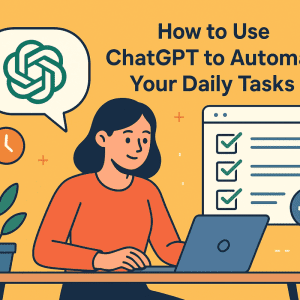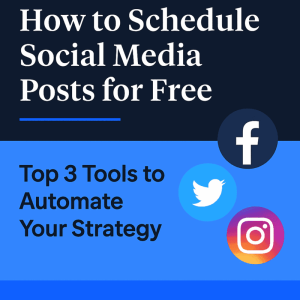Contents
Introduction: The Timeless Drive for Efficiency
(history of automation) From the first steam engines to today’s intelligent robots, humanity’s journey with automation has been nothing short of revolutionary. What began as a quest to reduce manual labor in the 18th century has evolved into a sophisticated network of machines and algorithms capable of decision-making, problem-solving, and even creativity.
For bloggers and digital marketers, understanding the history of automation isn’t just a trip down memory lane — it’s a powerful way to predict and adapt to future industry changes. The more you understand where automation came from, the better prepared you’ll be for where it’s going.
Staying productive as a blogger in 2025 means using the right tools to save time and scale your growth. Our latest guide on the Top 7 Automation Tools Every Blogger Needs in 2025 covers everything from content scheduling to SEO optimization, helping you streamline tasks and focus on creativity. Don’t miss these must-have blogging tools! Read More…!
1. The Industrial Revolution: The Birth of Mechanical Automation
Steam Power and the First Machines
The late 18th century marked the start of the First Industrial Revolution, powered by steam engines, mechanized looms, and factories. These innovations transformed agriculture-based societies into manufacturing powerhouses.
Key developments included:
- The Spinning Jenny (1764) – revolutionized textile production.
- Steam Engine (1770s) – powered factories, trains, and ships.
- Mechanized Looms (1780s) – reduced manual weaving labor drastically.
While these machines required human oversight, they paved the way for thinking about work as a process that could be scaled and automated.

2. The Second Industrial Revolution: Electrification and Mass Production
By the late 19th and early 20th centuries, electricity replaced steam as the main driver of progress. Mass production became the new standard, with assembly lines revolutionizing industries like automobile manufacturing.
Key highlights:
- Electric Motors – improved reliability and efficiency in factories.
- Henry Ford’s Assembly Line (1913) – cut car production time from 12 hours to 90 minutes.
- Telegraph and Telephone – automated communication over long distances.
For the first time, humans and machines worked in precisely coordinated sequences, maximizing speed and output. history of automation.
3. The Digital Revolution: Computers and Early Programming
The mid-20th century introduced electronic automation through computers, microprocessors, and early programming languages.
Notable milestones:
- First Programmable Computers (1940s) – ENIAC and UNIVAC could handle calculations faster than any human.
- Industrial Robots (1961) – Unimate became the first robotic arm used in automotive production.
- Programmable Logic Controllers (PLCs) – allowed flexible, software-driven control of manufacturing systems.
For marketers and bloggers, this era was also when data storage and processing first became possible, setting the stage for future digital marketing tools. history of automation.
4. The Age of the Internet: Networking Automation
The 1990s brought the World Wide Web, enabling information to travel instantly across the globe. Automation expanded beyond factories into:
- Email Marketing – automated campaigns and newsletters.
- Search Engines – algorithms sorting and ranking web pages.
- E-commerce Platforms – automated order processing and payments.
This was when digital marketing automation truly began — CRM systems, analytics tools, and online ad platforms started to replace manual campaign management.
5. The AI Era: Intelligent Automation
In the 21st century, automation entered its smartest phase yet — Artificial Intelligence (AI) and Machine Learning (ML). Unlike earlier machines that simply followed instructions, AI systems learn from data and make autonomous decisions. history of automation.
Examples include:
- Chatbots & Virtual Assistants – handling customer queries instantly.
- Predictive Analytics – anticipating user behavior for targeted marketing.
- Automated Content Creation – AI tools generate blog posts, product descriptions, and social media captions.
- Smart Manufacturing (Industry 4.0) – IoT-connected devices optimizing production in real-time.
(Image placement suggestion: Supporting image showing AI, robots, and digital interfaces in a flat vector style.)
6. Industry 4.0: The Connected Era
The latest phase of automation — Industry 4.0 — combines advanced manufacturing with real-time data exchange. It’s not just about robots and algorithms; it’s about systems talking to systems without human intervention.
Key characteristics of Industry 4.0:
Internet of Things (IoT): Machines and sensors communicate instantly to optimize workflows.
Cloud Computing: Accessing automation tools from anywhere, enabling remote operations.
Big Data Analytics: Turning massive datasets into actionable insights for decision-making.
Augmented Reality (AR): Real-time overlays for maintenance, training, and marketing visualization.
For digital marketers, Industry 4.0 means real-time customer data and hyper-personalized campaign automation at a scale that was impossible before. history of automation.
7. Marketing Automation: A Parallel Evolution
While industrial automation evolved over centuries, marketing automation has transformed in just a few decades.
Early stages:
Bulk Email Tools (1990s) – the earliest form of marketing automation.
CRM Integrations (2000s) – linking customer data to marketing actions.
Social Media Scheduling (2010s) – streamlining posting and engagement.
Now:
AI-Powered Ad Targeting – serving personalized ads to the right audience at the right time.
Content Generation Tools – AI writing assistants producing blogs, captions, and product descriptions.
Automated Funnels – AI-driven systems that nurture leads until they’re ready to buy.
This parallel journey shows that automation isn’t limited to manufacturing — it’s reshaping how marketers attract, convert, and retain customers.
8. Challenges of Automation
Automation’s growth hasn’t been without challenges. For bloggers and marketers, these include:
Job Shifts – Roles change, requiring upskilling in AI and data analysis.
Data Privacy – Automated systems must comply with laws like GDPR.
Content Authenticity – AI-generated content can lack the human touch if not supervised.
Over-Reliance on Tools – Automation should assist, not replace, strategic thinking.
Pro Tip: Always combine automation with a human-driven creative strategy to maintain authenticity and trust.
9. The Road Ahead: Automation in 2030 and Beyond
Looking forward, experts predict:
Fully Autonomous Factories – minimal human oversight.
AI-Driven Creativity – generating designs, scripts, and campaigns based on real-time audience trends.
Global Collaboration – instant translation and cultural adaptation of marketing content.
Sustainability Automation – machines optimizing energy use and reducing waste.
For marketers and bloggers, the focus will shift from manual creation to creative direction, strategy, and storytelling — letting AI handle repetitive execution.
Final Thoughts
From the clanking gears of steam engines to the silent efficiency of AI, automation’s journey has been one of constant innovation. Every phase has reshaped industries, economies, and skills. The lesson for modern professionals?
💡 Automation is not the end of creativity — it’s the beginning of a new creative era.
The future belongs to those who can blend human insight with machine efficiency, using automation as a tool for innovation rather than a replacement for imagination.
For Bloggers & Digital Marketers: Why This History of Automation Matters
- Predict Future Trends – Understanding the past evolution of automation helps forecast upcoming marketing technologies.
- Leverage New Tools Early – Early adopters of automation tools often gain a competitive advantage.
- Adapt Content Strategies – AI-generated content is growing, but human creativity remains essential for authenticity.
Conclusion: From Steam to Smart Machines
The history of automation shows one thing clearly — change is constant. Each phase, from steam power to AI, has transformed not only industries but also the skills we need to thrive. For bloggers and digital marketers, embracing automation is no longer optional — it’s the key to staying relevant and competitive history of automation.
To explore more about automation, Click Here.
Do follow us on YouTube




